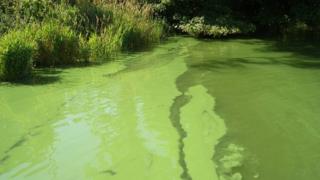
Image copyright
Centre for Ecology & Hydrology
A freshwater ecologist says blue-green algae had been a particular problem this summer
Potentially toxic algae is blooming in rivers and lochs during Scotland’s long, hot summer, scientists have warned.
Blue-green algae, which poses a health risk to humans and animals, has flourished during the warm spell.
The algae has reportedly led to the death of two dogs after they ingested the substance earlier this summer.
Now scientists are urging people to record sightings of the algae in a bid to speed up response times.
Freshwater ecologist Prof Laurence Carvalho said blue-green algae had been a particular problem this summer.
“Not only has it been very warm but it has also been very dry, which means they have not been flushed out of water courses by rain,” he said.
It is posing a particular risk to dogs who appear to be attracted by the smell, he added.
Earlier this month a dog reportedly died from algae poisoning after drinking water from the River Conon, near Maryburgh in the Highlands.
A similar incident is reported to have happened in Loch Awe in May.
Skin rashes
Prof Carvalho said: “Animals will drink from water if they are thirsty and it seems dogs are particularly affected because they seem to be attracted by the smell of the algae.”
Blue-green algae are microscopic, but clump together in visible colonies up to a few millimetres in size that can rise to the surface and form thin wispy green blooms or thick, paint-like scums.
When it is ingested, it can cause damage to the liver or the nervous system in humans and animals.
People who have been swimming in or have swallowed algal scum can suffer from skin rashes, eye irritation, vomiting, diarrhoea, fever and muscle and joint pain but there is no evidence of long-term effects or death among people in the UK.
Prof Carvalho, who works at the Centre for Ecoology and Hydrology, has helped develop an app called Bloomin’ Algae which allows users to submit images of the bloom and its location.
The information will be passed on to the Scottish Environment Protection Agency, so it can inform local authorities.
He said: “The app provides an early warning system and speeds up the process of local authorities or landowners putting up signs at sites where there is blue-green algae, to warn the public of the risks.
“It will also help us understand the drivers of growth of these algae, such as the impact of climate change.”



